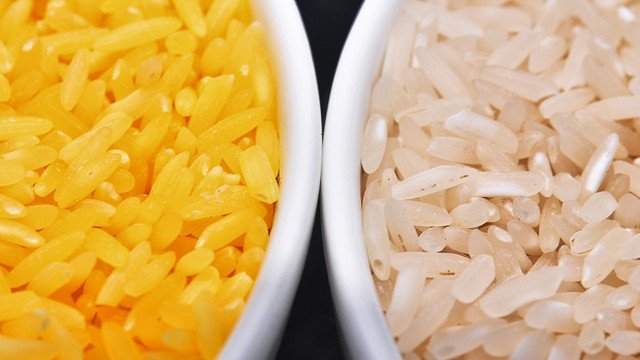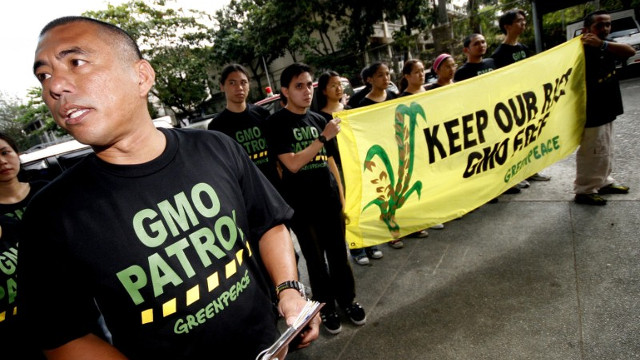SUMMARY
This is AI generated summarization, which may have errors. For context, always refer to the full article.

MANILA, Philippines – Last August, around 400 farmers uprooted the genetically-modified crop Golden Rice grown in a government-owned testing field in Pili, Camarines Sur.
Condemned as an act of vandalism by pro-GMO scientists, the uprooting was the farmers’ way of protesting the planting of Golden Rice on Philippine soil.
They contended that far from benefiting farmers, Golden Rice will contaminate native rice crops and pose risks to public health and the environment. Once GM crops are exposed to nature, there is no recalling their unforeseen impact on soil, organisms and nearby crops.
The farmers, members of anti-GMO alliance SIKWAL-GMO, also decried the lack of consultation with Bicolano farmers.
“Last February, we had a dialogue with officials from the Department of Agriculture. After airing our concerns, they promised us that they will not conduct any Golden Rice field trials. However, they still continued these clandestine field trials,” alliance spokesperson Bert Aunor was quoted as saying in news reports.
“We are very concerned as news about feed testing will start this year and that the harvest will be used in these feed experiments.”
The Golden Rice field test trials are being conducted by the Philippine Rice Research Institute in partnership with the Department of Agriculture.
Unlike normal rice, the distinctly yellow Golden Rice has been genetically-engineered to contain more beta carotene, a precursor of Vitamin A. While beta carotene is found in the leaves of the rice plant, scientists found a way to insert genes from bacteria and corn into the edible parts of the plant so that beta carotene is produced in the grains as well.
Golden Rice has been touted as the “poster boy” of genetically-modified organisms or GMOs because it is said to address Vitamin A deficiency, a leading cause of blindness in children all over the world.
The World Health Organization estimates that 250,000 to 500,000 children become Vitamin A deficient each year, half of them dying within months of losing their sight.
‘GMO-friendly’ country
While Golden Rice is still being tested, a total of 44 GMOs have been approved by the government: 40 for direct use as food, animal feed and food processing and 4 for planting as crops. Most of these are genetically-altered corn, soybean, potato, canola, cotton, sugarbeet and alfalfa.
They have been genetically-engineered to resist pests and herbicides, delay ripening or enhance their nutritional value.
 All of these approved GMOs are products of big multinational agro-chemical companies like Monsanto, Syngenta, Bayer and Pioneer which own patents to these crops.
All of these approved GMOs are products of big multinational agro-chemical companies like Monsanto, Syngenta, Bayer and Pioneer which own patents to these crops.
Daniel Ocampo, Sustainable Agriculture Campaigner of environment group Greenpeace, is disturbed by how “friendly” the Philippines is to GMOs despite more than 60 countries in the world, including Japan, Australia, and countries in the European Union already putting restrictions and bans on GMOs.
“We are the only Southeast Asian country that allows the planting of a GM food crop. Our neighbors are more cautious in approving GMOs. Our government is approving left and right. At the rate we’re going, there are approvals every one-and-a-half months.”
Thelma Soriano, senior agriculturist of Biotech Core Team, the government agency charged with approving and monitoring GMO applications, said, “We are not ‘so open’ to GM crops. The Philippines is just open to all agricultural tools, methods, and technologies that can be of help to the Filipino farmer, so long as this is safe for human and animal consumption and the environment.
“Crop biotechnology is just an option. It is the farmers who will decide if they need the technology or not for their particular farm.”
But Ocampo tells a different story.
“First, these companies use promotions and discounts. They give farmers free trial seeds for planting. May raffle pa nga yan (they even raffle them off). Some of the farmers we’ve talked to, especially the small landholders, most of them have tried planting GM corn but after one planting season, they quit. But they are forced to plant it again because the credit facilities they borrow from will only grant them loans if they plant GM corn. These facilities are partly funded by GM companies like Monsanto.”
Even more disturbing is how GM companies package their GM crops with their other products. For instance, Roundup Ready corn by Monsanto is genetically-programmed to be resistant only to Roundup herbicide, a product also by Monsanto.
Soriano admitted that Biotech Core Team (BCT) “has never encountered denying a GM crop for direct use for food, feed or for processing. So far, all of the GM crops applied for these purposes have first been developed as a complete finished product and approved for direct use as food, feed or processing in the country of origin.”
This, despite the existence of the Organic Agriculture Act (Republic Act 10068) that clearly excludes GMOs in its definition of the agricultural systems the government should be promoting.
Today, more than 50% of food in an average grocery in the Philippines are GMOs or contain GMOs, estimated Ocampo.
“If it’s highly processed, it will probably contain canola, extenders like corn and soya, and these are imported from the US where GMOs are one of their largest industries.”

Health, environmental harms
But what, really, are the harms posed by GMOs? Genetically-altered food has been consumed by humans since 1994 when GM tomato was first marketed in the US.
Though no one has died from eating GM food, Ocampo said genetic engineering is too new a technology for us to see long-term impact on human health.
But some of these possible effects have already been reported in animals fed with GMOs.
A 2009 study published by the International Journal of Biological Sciences reported disturbances in the organ functions of rats fed with 3 types of GM corn, including Roundup Ready corn by Monsanto.
The two other varieties, also found in the market today, are genetically engineered to produce their own insecticide.
The study reported distrubances in the rats’ kidney and liver, and effects in their heart, adrenal, spleen and blood cells.
“The highly statistically significant disturbances in the function of these organs, seen between male and female rats, cannot be dismissed as biologically insignificant as has been proposed by others,” read the report.
“We therefore conclude that our data strongly suggest that these GM maize varieties induce a state of hepatorenal toxicity.”
Hepatorenal toxicity can ultimately lead to hepatorenal syndrome, a life-threatening condition characterized by the rapid deterioration of kidneys.
If alarming health risks like these have not yet manifested, the environmental impact of planting GM crops already have.
A Cornell study reported that toxic pollen from Bt (Bacillus thuringiensis) corn has led to the deaths of monarch butterflies. Though Bt corn produces its own insecticide to kill crop-damaging pests, it also kills “nontarget” organisms like honeybees and ladybugs, which are essential to agricultural ecosystems as pollinators or predators of pests.
But the fact that many aspects of GMOs remain a mystery does not mean the technology should be condemned outright, said Dr Ben Peczon, a scientist and member of pro-GMO Biotechnology Coalition of the Philippines.
“Yes, all the effects of GMOs are not known and probably will never be. Such is the way of our wonderful existence. The point is there will never be total consensus. The majority of scientists approve of the use of responsible genetic modification. I repeat, the code words are safe and responsible use of modern biotechnology. Naysayers will always be there.”

Do we need GMOs?
Peczon maintains that GMOs can be a boon to the country, if given a chance.
“The Philippines needs food, fuel and fiber for its population and to create assets. Biotechnology is a tool to help meet these needs. Our country has finite land to grow needed crops. The country therefore must produce more from this finite amount of land to meet the needs of an increasing population,” he told Rappler.
GMOs can increase crop yield per hectare by genetically-coding crops to protect themselves from pests and herbicides.
But a United Nations-commissioned report says that the world can get by without GMOs. While GMO use is largely concentrated in countries like the US, Argentina, Brazil and Canada, 93% of the planet’s cultivated land still uses conventional farming.
Higher yield can be achieved through organic agricultural techniques like multi-crop planting and the use of natural “pesticides” like lemongrass, roots of the tubli plant, and vines of manunggal, said Ocampo.
Fork in the road
Today, GMOs in the Philippines reach a crux with the judiciary blocking the approval of Bt eggplant or “super talong.”
Last May, the Court of Appeals stopped the nationwide field testing of the GM eggplant saying, “there is no full scientific certainty yet as to the effects of Bt talong field trials to the environment and to the health of the people.”
Read the complete decision here.
It chose to uphold the precautionary principle which states that “when human activities may lead to threats of serious and irreversible damage to the environment that is scientifically plausible but uncertain, actions shall be taken to avoid or diminish the threat.”
The petition was filed by Greenpeace and farmers’ group Masipag who opposed the field testing being done by respondents UP Los Baños Foundation Inc, UP Mindanao Foundation Inc, the Department of Agriculture, and the Department of Environment and Natural Resources.
But the respondents filed a motion for reconsideration in June.
Those on either side of the GMO fence wait with bated breath for the judiciary’s next move. A final decision on Bt talong could determine the direction the entire country will take on GMOs. – Rappler.com
Corn image from Shutterstock
Add a comment
How does this make you feel?
There are no comments yet. Add your comment to start the conversation.